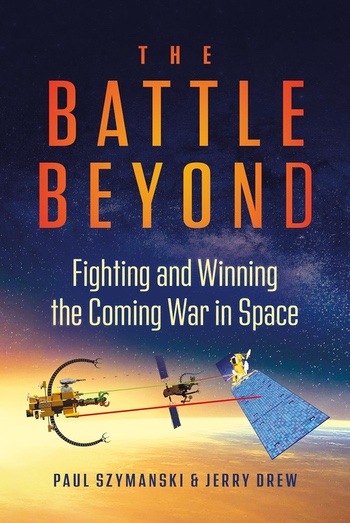Review: The Battle Beyondby Jeff Foust
|
| “If space is a warfighting domain, as US policy now states, then it requires a language—to the greatest extent possible—that is familiar to other warfighters,” they write. |
That discussion has highlighted growing concerns about the threats to satellites in any future conflict. US military officials now frequently describe space as a warfighting domain with the expectation that, in any future major conflict, military and even commercial satellites could be subject to threats ranging from jamming and cyberattacks to kinetic ASATs (and, apparently, Russian nukes.) In The Battle Beyond, Paul Szymanski and Jerry Drew discuss how to study space warfare, but using an approach that may be useful only to a fairly narrow audience.
The key issue for understanding space warfare, the authors argue, is language. “If space is a warfighting domain, as US policy now states, then it requires a language—to the greatest extent possible—that is familiar to other warfighters,” they write. Much of the book is spent translating existing terminology used by the US military into concepts suitable for attacking and defending space assets. That includes one chapter where the authors take the military’s “principles of war” or “principles of joint operations”—concepts like mass, maneuver, and surprise—and discuss how they apply to space warfare.
The authors note in the introduction that the “primary audience for this discussion is the military practitioner,” and that becomes clear as the authors work through topics from strategic to operational levels. If you’re curious to know how ASAT weapons might work, or what is known at least from unclassified and open sources about Chinese and Russian capabilities, you won’t find much here. But if you want to understand how to communicate space warfare in ways that warfighters in other domains might understand, this may be the book for you. (The book includes nearly 15 pages of testimonials, primarily from current and retired generals and admirals from the US and allied militaries, including former general and CIA director David Petraeus.)
However, the authors’ approach to the subject might be pushing it even for a military audience. For example, the authors spend dozens of pages describing, in great detail, symbols for depicting space assets and threats, a symbology of their own design but based on Defense Department standards. That is material that seems like could be better placed in an appendix, especially since those symbols are used infrequently in the rest of the book. Many of the other illustrations in the book, including screenshots of the authors’ software for modeling space warfare activities, are printed too small to see useful details. The book also curiously lacks an index.
| The authors note in the introduction that the “primary audience for this discussion is the military practitioner,” and that becomes clear as the authors work through topics from strategic to operational levels. |
The Battle Beyond does briefly mention the one space warfare option that has generated recent headlines: detonating a nuclear weapon in orbit. Szymanski and Drew argue that a country like North Korea that is less dependent on space might be willing to do so to “render a key portion of their enemy’s satellite fleet inoperable or large portions of space unusable.” That would appear to make Russia less likely to use such a weapon, although its once-significant space capabilities have been eroding in recent years, a decline accelerated by sanctions imposed after its full-scale invasion of Ukraine two years ago.
“One might even consider the possibility that if a country is willing to suffer the consequences of detonating nuclear weapons, space might not be the best place to do so because of the potential for diminished political or psychological impact,” they add. “After all, there will be no smoking hole in the ground afterward.” If that was meant to assuage concerns about the most severe aspects of space warfare, it may not exactly leave the reader relieved.
Note: we are now moderating comments. There will be a delay in posting comments and no guarantee that all submitted comments will be posted.
